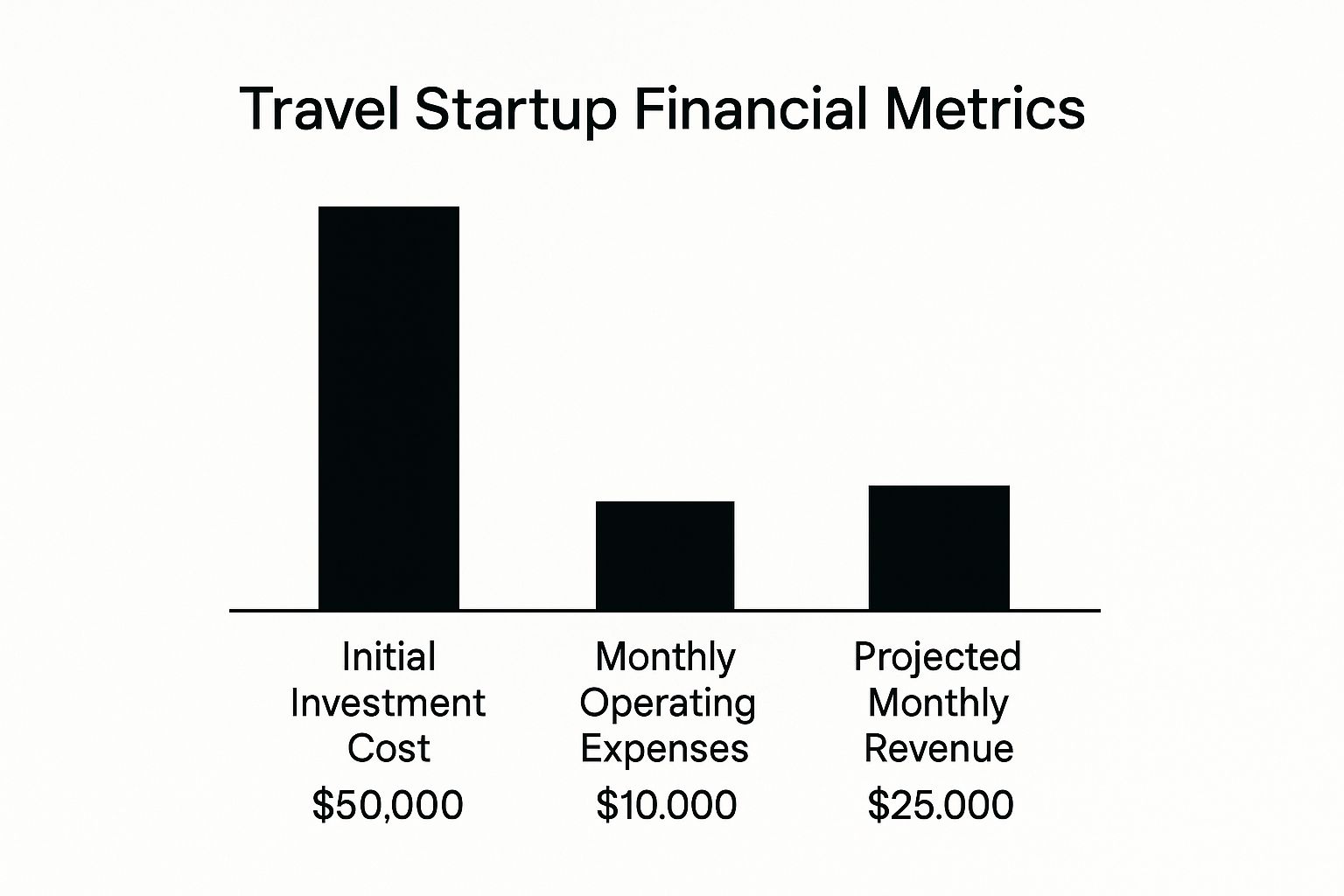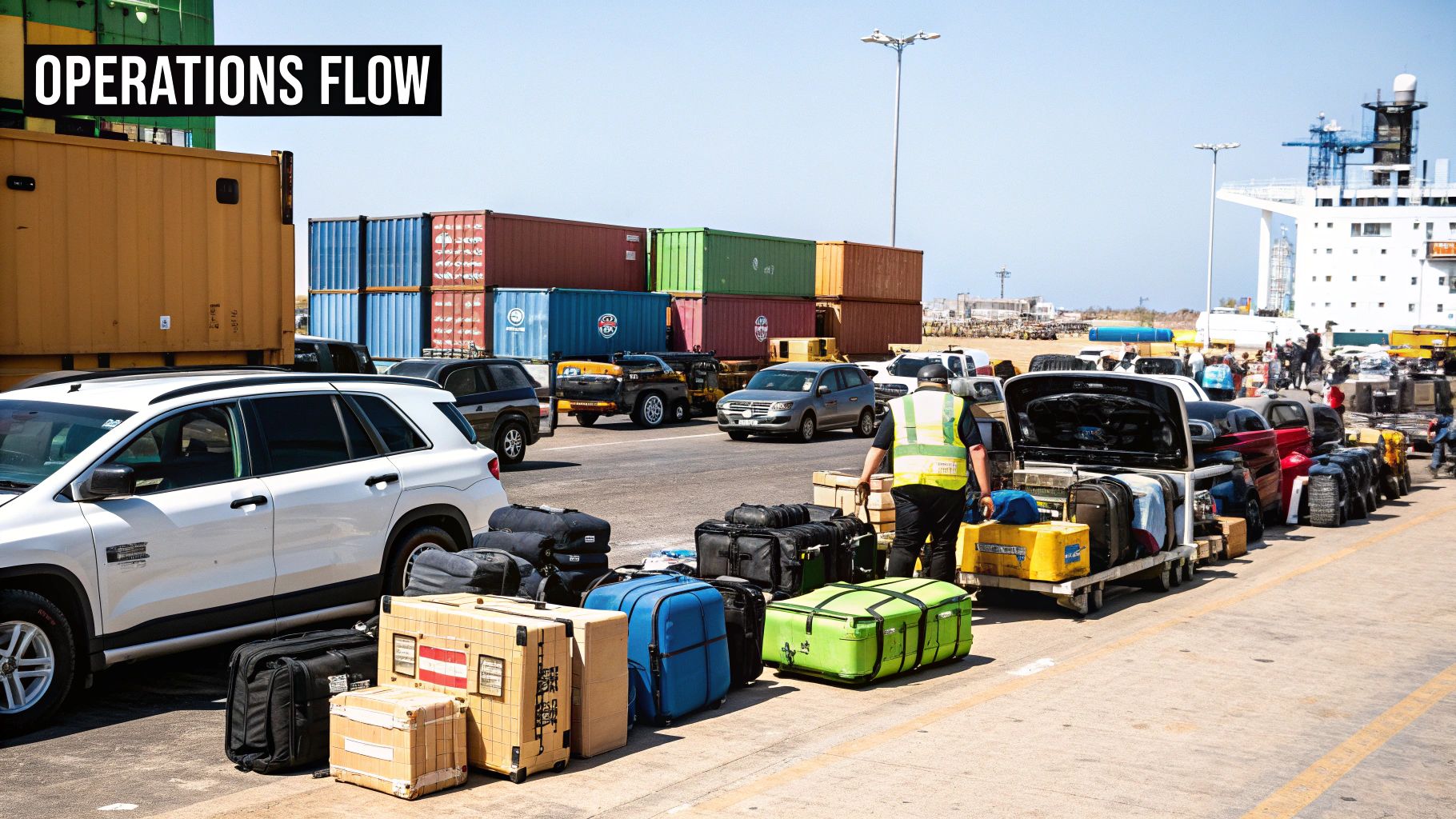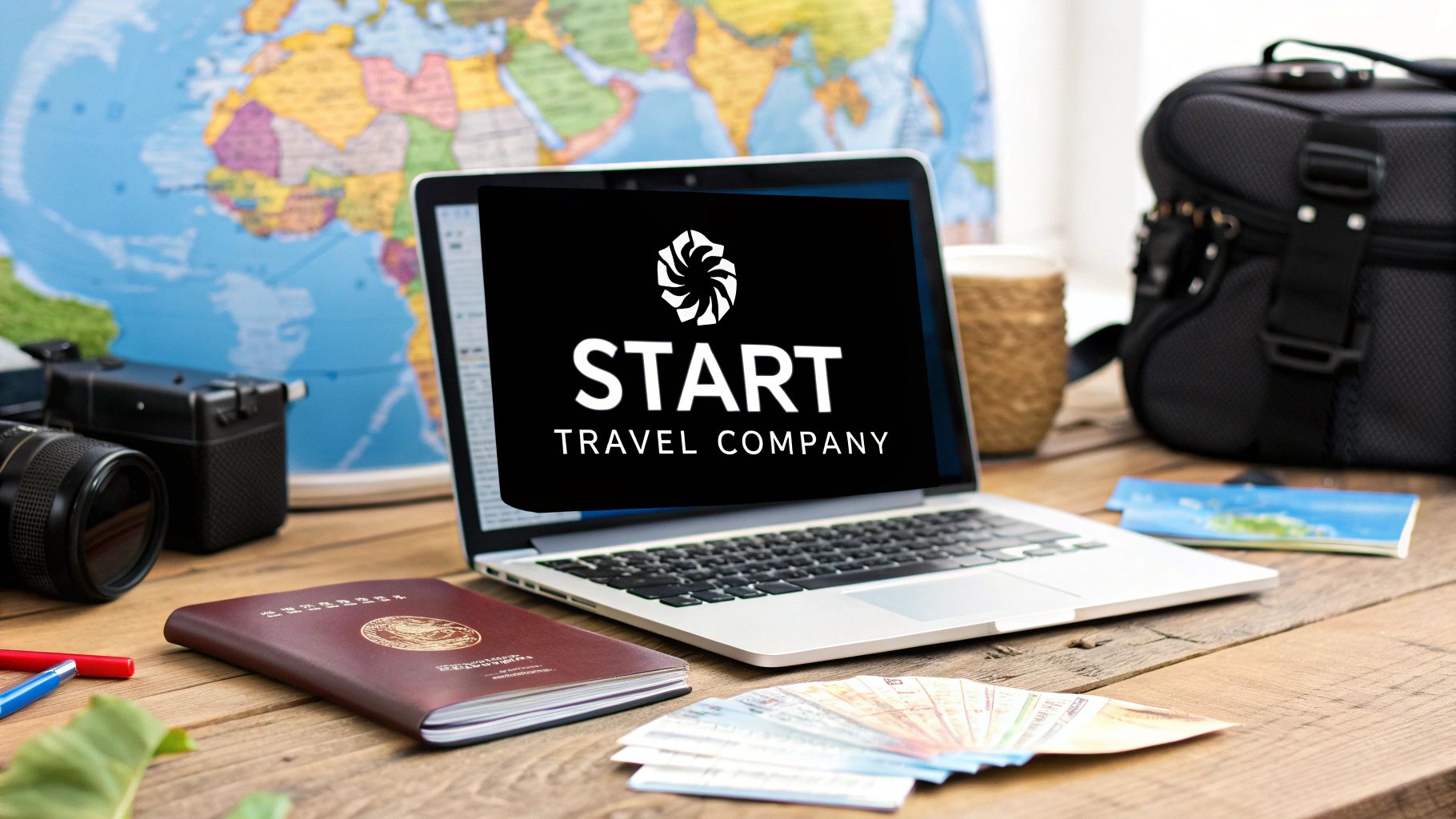So you want to start a travel company. The first, most critical decision you'll make isn't about logos or websites—it's about defining your niche. This is where you go from a passionate traveler to a focused entrepreneur.
You can't just be a "luxury travel" agent anymore. The market is flooded. For a small entrepreneur, a sharp, specific focus is your competitive advantage. Think "sustainable trekking adventures in Patagonia for millennials" or “immersive culinary tours through Vietnam’s lesser-known regions.” This single decision will guide your business model, marketing plan, and every other choice you make.
Finding Your Niche in a World of Travelers

Before you design a single itinerary, you have to carve out your space. A generic approach is the fastest way for a small business to get lost in the noise. True success comes from specialization. When you become the go-to expert for a very specific type of travel, you attract clients who are already looking for exactly what you offer. It makes your marketing a million times easier and your brand unforgettable.
Brainstorming Your Niche
So, where do you start? Look inward. Your best niche usually sits at the intersection of your passion, your personal expertise, and what people are actually willing to pay for. Don't just think about places you've been; think about how you travel and what truly gets you excited.
Here are a few ways to slice it:
- By Travel Style: Are you all about high-octane adventure travel? Or maybe slow-paced wellness retreats or budget-friendly backpacking is more your speed.
- By Destination: Do you know a single country, region, or even a city like the back of your hand? Your deep local knowledge is a massive asset for a small operator.
- By Traveler Demographic: You could design incredible trips for solo female travelers, families with young children, or retirees craving cultural immersion.
- By Activity or Interest: Think outside the box. What about culinary tours, wildlife photography expeditions, historical battlefield tours, or even music festival packages?
Let's make this real. A love for food and Southeast Asia could become "Small-Group Street Food Tours in Hanoi." A passion for hiking and conservation could turn into "Eco-Lodge Trekking Adventures in Costa Rica." The more specific you get, the clearer your ideal customer becomes. If you're leaning toward creating intimate lodging experiences, our sample business plan for a bed and breakfast can offer some great insights.
Validating Your Idea
Okay, you've got a few solid ideas. Now for the reality check: is anyone actually going to pay for this? A passion project is great, but a small business needs to be profitable. It's time for some down-to-earth market research to see if there's real demand.
A common mistake new entrepreneurs make is building a product they think people want. Instead, find out what people already want and build a company that delivers it better than anyone else.
Go hang out where your target audience lives online. Dive into Reddit forums, Facebook groups for specific travel styles, and the comment sections of popular travel blogs. What questions are people asking over and over? What are their biggest frustrations with the options out there? These pain points are pure gold—they're the unmet needs you can build your business around.
Then, do a little competitor recon. See what other companies in your potential niche are doing. Scour their websites, social media, and customer reviews. What are they nailing? And more importantly, where are the gaps? Maybe their tours are too big and impersonal, their itineraries feel rushed, or they completely ignore sustainability. Those weaknesses are your openings. This groundwork isn't just busywork; it's the foundation of a travel business that will actually last.
Choosing the Right Business Model and Legal Setup
https://www.youtube.com/embed/ZEMbKzy7FD8
Alright, you've zeroed in on your niche. Now for the nuts and bolts: how are you actually going to run this thing and make money? Picking a business model isn't about finding some "perfect" formula. It’s about matching your vision with your reality—your budget, how much risk you're comfortable with, and what you want your day-to-day life to look like as a small business owner.
When you want to start a travel company, there are a few tried-and-true paths perfect for entrepreneurs. This decision is the blueprint for your entire operation, influencing everything from your daily tasks to your legal paperwork.
Popular Travel Business Models for Entrepreneurs
Let's walk through the most common ways new travel pros get their start. Each has its own set of pros and cons, so think about which one feels right for you as a solo entrepreneur.
-
Home-Based Travel Agent (Affiliated with a Host Agency): This is, without a doubt, the fastest and cheapest way to get into the game. You're essentially partnering with a larger, established host agency. This gives you instant access to their booking software, supplier connections, and industry credentials (like an IATA number), which can take years to build on your own. You earn commissions on the trips you sell, and the host agency takes a small percentage. It's a fantastic model if you want to focus entirely on building client relationships and selling travel, without getting bogged down in administrative headaches.
-
Independent Tour Operator: If you're a creator at heart, this one's for you. As an independent operator, you design, package, and sell your own unique tours from scratch. Imagine crafting a week-long food tour through Vietnam or a guided hiking trip through Patagonia. You have total creative control over the itinerary, the pricing, and the entire client experience. The profit margins can be much higher here, but so is the responsibility. You’re on the hook for everything—vetting suppliers, managing complex logistics, and handling all customer issues.
-
Content-Driven Travel Consultant: This is a more modern approach that plays the long game. You start by building an audience around your travel niche through a blog, a YouTube channel, or a strong social media presence. Your expertise becomes your product. At first, you might make money from affiliate links (recommending hotels and gear you love), but over time, you can sell digital guides or offer paid, one-on-one travel planning services. It takes patience and a knack for content creation, but it offers incredible freedom and multiple revenue streams for a small business.
This infographic breaks down some of the financial realities of launching a travel business, comparing the startup costs against ongoing expenses and potential income.

As you can see, keeping initial costs low is manageable. The real challenge is building a steady stream of revenue to cover your monthly costs and turn a profit.
Before we move on, let's compare these models side-by-side.
Comparing Common Travel Business Models
| Business Model | Typical Startup Cost | Primary Revenue Source | Best For |
|---|---|---|---|
| Home-Based Agent | Low ($500 – $3,000) | Sales Commissions | Beginners, solo agents, and those wanting low overhead. |
| Independent Tour Operator | Medium to High ($5,000 – $25,000+) | Tour Package Sales (Direct) | Experts in a specific destination or activity with a strong vision. |
| Content-Driven Consultant | Low to Medium ($1,000 – $7,000) | Affiliate Marketing, Digital Products, Consulting Fees | Writers, creators, and influencers with patience to build an audience first. |
Each path has its own financial and operational footprint. The key is choosing the one that aligns with your personal strengths and starting resources.
Nailing Down Your Legal Structure
Once you've landed on a business model, it's time to make it official. The legal structure you choose is a critical decision that impacts your taxes, paperwork, and, most importantly, your personal liability. This is what separates your personal finances from your business finances.
For most small entrepreneurs starting out, it really boils down to two options:
-
Sole Proprietorship: This is the default, simplest way to get started. You and your business are one and the same in the eyes of the law. It’s easy and cheap to set up, but it comes with a major catch: you have zero liability protection. If your business runs into legal trouble, your personal assets—your house, your car, your savings—are on the line.
-
Limited Liability Company (LLC): An LLC creates a legal wall between you and your business. It protects your personal assets from any business debts or lawsuits. Think of it as a hybrid, offering the protection of a corporation but with less complexity. Yes, it involves a bit more paperwork and a filing fee, but the peace of mind it provides is worth every penny for a small business owner.
Key Takeaway: For the vast majority of new travel entrepreneurs, forming an LLC is the recommended path. The protection it gives you from business liabilities is a safety net you really can't afford to skip.
Getting your legal house in order doesn't stop there. You'll also need to register your business name, get an Employer Identification Number (EIN) from the IRS if you plan to hire anyone (even contractors), and open a separate business bank account. Keeping finances separate from day one is non-negotiable.
Always check for any specific licenses your state or city requires for travel sellers. And if you’re focused on a specific country, you'll need to understand their rules; for instance, here’s a guide to Starting a Business in Thailand. Finally, get Errors & Omissions (E&O) insurance. This is your professional liability insurance, and it protects you if a client claims you made a mistake in their travel plans. It's an absolute must-have. For a deeper dive into the documents involved in setting up a company, our guide on the https://growth-grid.ai/docs/memorandum-of-association can shed more light on the process.
Charting Your Course with a Solid Business and Marketing Plan
A brilliant idea is where the journey begins, but it won't get you far without a map. To actually start a travel company and make it a success, you need a clear roadmap that turns your vision into a real, functioning business. For a small entrepreneur, this boils down to two key documents: your business plan and your marketing plan.
Let's be clear—forget those dusty, 100-page business plans from a bygone era. We're talking about lean, practical guides built for a modern entrepreneur who needs to stay agile.
Your business plan is your internal compass. It's where you get brutally honest about your mission, who you're trying to reach, how you'll operate, and what the numbers look like. It doesn’t have to be formal, but it absolutely must be clear. This is the document that forces you to answer the hard questions before you sink a ton of time and money into the venture.
Building Your Lean Business Plan
A lean plan is all about cutting through the noise. Instead of pages of fluff, it hones in on the most critical parts of your business, often on a single page or in a short document. Think of it as a living guide—one you can easily update as a solo entrepreneur as you learn and grow.
Your plan should get straight to the point on these key areas:
- Your Mission: What's your "why" beyond just making money? Something like, "To offer immersive, eco-conscious trekking adventures in Patagonia for solo travelers."
- Target Market: Get specific. Who are you really serving? For example: "Millennial and Gen Z professionals, aged 25-40, who value authentic experiences and sustainability over luxury."
- The Problem You Solve: What pain point are you actually fixing? "Travelers crave unique, off-the-beaten-path experiences but don't have the time or local know-how to plan them safely."
- Your Solution: How do your services solve that exact problem? "We provide curated, all-inclusive trekking packages with expert local guides and pre-vetted eco-lodges."
- Revenue Streams: How will the money flow in? Be specific about commissions, package markups, or any consulting fees.
- Financial Projections: Whip up a simple spreadsheet. List your startup costs, estimate your monthly expenses, and set some realistic sales goals for your first year.
The real purpose of a business plan isn't just to impress investors; it's to force you to think strategically. It’s your best chance to spot potential roadblocks and uncover hidden opportunities before they become expensive lessons.
Putting this document together is a foundational step that will guide every other decision you make. If you want a structured way to really pressure-test your concept, exploring a feasibility study framework can bring a whole new level of clarity.
Crafting a High-Impact Marketing Plan on a Budget
With your business plan as your North Star, it's time to figure out how you'll actually attract your first customers. For a small travel company, a marketing plan shouldn't mean blowing a huge budget on ads. The focus should be on high-impact, low-cost strategies that build trust and establish you as an expert.
Your marketing efforts need to be grounded in what's happening in travel right now. The demand is not only strong but it's also changing. In the U.S., travel spending surged after the pandemic and is expected to keep climbing, projected to hit $1.35 trillion in 2025. This confidence means people are planning more trips and longer ones.
What does this mean for you as a small business? It means technology is key. Travelers expect seamless digital experiences, from AI-powered recommendations to easy online booking. To learn more about where the industry is heading, you can check out these evolving travel industry trends on Deloitte.com.
Core Marketing Channels for Your New Travel Company
Focus your precious time and energy on the channels that give you the most bang for your buck as a small entrepreneur.
-
A Simple, Conversion-Focused Website: Your website is your digital storefront. It doesn't need to be complicated, but it must look professional, be a breeze to navigate, and clearly show what makes you special. Use stunning photos and write descriptions that make people want to pack their bags. Most importantly, make it ridiculously easy for visitors to contact you or book a consultation.
-
Strategic Content Marketing: This is your secret weapon for attracting ideal clients without paying for ads. A blog is the perfect place to show off your expertise. If you sell trips to Japan, write a post titled, "My Perfect 10-Day Itinerary for First-Timers in Japan." This kind of content builds authority and pulls in people who are actively dreaming about their next trip.
-
An Engaging Social Media Presence: Don't spread yourself thin trying to be everywhere. Pick one or two platforms where your target audience actually hangs out. If you're targeting millennials with visual, adventure-focused trips, Instagram and TikTok are no-brainers. Focus on creating content that tells a story, showcases your niche, and sparks that feeling of wanderlust.
-
Foundational SEO: Search Engine Optimization (SEO) is a marathon, not a sprint, but you need to start on day one. It’s as simple as using relevant keywords (like "solo travel Patagonia") in your website copy and blog posts. That way, when people search on Google for the exact trips you offer, they find you.
As you start planning your outreach, digging into some practical guides on digital marketing strategies for startups can give you a ton of actionable ideas. Remember, your marketing plan should be a living document that you tweak and refine as you learn what truly connects with your audience.
Building Partnerships and Designing Your First Packages

The success of your new travel company doesn't just ride on a slick website or a clever business plan. It’s all about the actual, real-world experiences you deliver to your clients. And those experiences are only as good as the partners you have on the ground.
Without a network of reliable suppliers, even the most beautifully designed itinerary can completely unravel. For a new entrepreneur, these partnerships are your lifeline—your eyes and ears in a destination, making sure your clients are safe, happy, and getting that authentic trip you promised. Building this network from scratch isn’t quick, but it’s one of the most important things you’ll do.
Forging Your Supplier Network
Your supplier network is made up of everyone from hoteliers and local tour guides to drivers and even restaurant owners. These are the people who will actually bring your travel packages to life. Finding the right ones is less about scrolling through huge booking sites and more about targeted, personal detective work.
Put yourself in your ideal client's shoes. Where would they want to stay? What kind of guide would they rave about? Dive into niche travel blogs, specialized forums, and social media groups dedicated to your destination. You're looking for providers who get consistently glowing, specific reviews that match your brand’s vibe, whether that’s sustainability, luxury, or high-octane adventure.
Once you’ve got a shortlist, it's time to vet them properly. This is how you separate the true professionals from the hobbyists.
- Make First Contact: Send a professional email introducing your company. Be clear about your niche, who you serve, and ask them directly for their B2B or travel agent rates.
- Verify Everything: Check for licenses, insurance, and any relevant certifications. For a guide, that might mean a first-aid certificate; for a transport company, you want to see their vehicle safety records.
- Jump on a Call: Always schedule a video interview. This is your gut check—a chance to gauge their passion, communication style, and how they handle pressure. Ask them real-world questions, like, "What’s your protocol if a client’s flight is cancelled at the last minute?"
Your partners are a direct extension of your brand. A client won’t care that it was the local guide who showed up late—they’ll blame your company. Every single partner has to reflect the quality you promise.
This groundwork is absolutely non-negotiable when you start a travel company. It’s the behind-the-scenes effort that builds a rock-solid reputation.
The Power of Host Agencies and Consortiums
If you're a new agent working from home, building a global supplier list can feel like an impossible task. This is exactly why partnering with a host agency or joining a travel consortium can be a game-changer for a small entrepreneur.
Think of it as a massive shortcut. These organizations have already done all the heavy lifting of finding and vetting thousands of suppliers worldwide. By joining them, you get immediate access to their entire network.
Even better, you get to tap into their immense buying power. This unlocks preferred rates, exclusive perks for your clients (like free breakfast or room upgrades), and higher commission levels that you simply couldn't get on your own. It allows you to offer more value and be more profitable from day one.
Crafting Irresistible Travel Packages
With a solid network of partners locked in, you can finally get to the fun part: designing your first travel packages. A great package is so much more than a bundle of services. It’s a seamless story that solves a problem for your client, giving them a curated experience they could never piece together on their own.
Start by theming everything around your niche. If you specialize in Italian culinary travel, don't just sell a generic "Trip to Italy." Create something specific and compelling, like a "Tuscan Farm-to-Table Cooking Adventure" or a "Sicilian Street Food & Culture Tour."
Next, you need to price for profit. This means knowing your costs, margins, and commissions inside and out. For every component—hotels, tours, transfers—you'll get a net rate (the wholesale price) from your suppliers. Then, you add your markup. A typical markup for custom packages can range anywhere from 15% to 30%, depending on how complex and unique the itinerary is. Your final price should reflect the incredible value and expertise you're providing, not just the raw cost of the parts.
It's Time: Launching and Finding Your First Paying Clients

This is the moment. Your business plan is solid, your first tour packages are designed, and the butterflies are probably kicking in. Launching your travel company can feel like a massive, nerve-wracking step, but it doesn't need to be a huge, expensive spectacle. Honestly, for a new entrepreneur, a quieter, more strategic approach works way better.
Instead of a "grand opening," think about a soft launch. It's your chance to pressure-test your systems, smooth out the bumps in your itineraries, and get that all-important social proof before you're in the full glare of the public spotlight. It’s the smartest way to manage risk and build real momentum.
The Power of a Pilot Trip
One of the best ways to pull off a soft launch is by running a "pilot trip." The idea is simple: offer your signature tour to a small, hand-picked group at a steep discount, or maybe even just for the cost of running it. The goal here isn't profit; it's about getting priceless, real-world feedback.
This first group essentially becomes your test audience and your first success story. Their experience will tell you exactly what’s working and what needs a little finessing before you start charging full price. More importantly, they’ll provide the two things a new travel business desperately needs:
- Powerful Testimonials: Nothing sells a trip like a genuine, glowing review from someone who’s actually lived it.
- High-Quality Photos and Videos: Authentic shots of real travelers having an amazing time are infinitely more compelling than generic stock photos.
Think of it as your final dress rehearsal. A fantastic pilot trip validates your entire concept and gives you the confidence—and the marketing assets—to go out and land your first full-paying clients.
Strategies to Get Your First Bookings
Once you've collected that feedback and those amazing photos, it’s time to switch gears and focus on revenue. And the timing couldn't be better. International travel is bouncing back in a big way. Between January and June 2025, nearly 690 million tourists traveled internationally, which is a 5% increase over the previous year.
The opportunity is definitely there. For instance, the United States is projected to welcome 77.1 million international visitors in 2025, a figure set to blow past pre-pandemic levels by 2026. While the pool of potential travelers is growing, you still need a sharp strategy to find your people. You can dig into more data on the global tourism recovery on UNTourism.int.
Your initial marketing goal isn't to reach everyone. It's to reach the right people—those adventure-seekers who are most likely to book with a new, specialized company just like yours.
Forget casting a wide net. Focus your energy here:
- Tap Into Your Personal Network Authentically: Don't just spam your social feeds with a generic "I started a business!" post. Reach out to people one-on-one. Tell them about the unique trips you’re running and exactly who your ideal traveler is. You'd be surprised who in your circle knows someone dreaming of the very experience you're selling.
- Get Active in Niche Online Communities: Find the specific Facebook groups, Reddit forums, or travel blogs where your target audience hangs out. Don't just show up and drop links. Be a genuine part of the community. Answer questions, share your expertise freely, and offer helpful advice. This is how you build trust and become the go-to expert.
- Use Smart Introductory Offers: Create a little buzz with a limited-time launch promotion. It could be a percentage off your first tour, a valuable add-on like a free city excursion, or an exclusive bonus for the first five people who book.
Setting Up for Smooth Transactions
Finally, make sure your booking and payment process is simple, secure, and professional. This is a critical moment that can either build a client's confidence or send them running. You don't need a custom-built, complicated system right out of the gate.
Services like Stripe or PayPal are easy to integrate into a website for secure payments. For the booking side, you can start with a simple contact form and manage everything via email, or use an affordable booking calendar tool. The key is to make it seamless and inspire trust from that very first click.
Common Questions About Starting a Travel Company
Even with the best-laid plans, a few nagging questions always pop up when you decide to start a travel company. Let's tackle some of the most common hurdles I've seen aspiring travel pros face, so you can move forward with a clear head.
How Much Money Do I Really Need to Start?
This is the big one, and the honest answer is: it completely depends on your business model.
If you’re going the home-based route and joining a host agency, you can get your feet wet for as little as $500 to $3,000. That usually covers your startup fees, some essential training, and a simple website to get you going. It's a fantastic, low-risk way to enter the industry.
On the other hand, if you're dreaming bigger and launching a full-fledged independent tour operator, you'll need more runway. Think closer to $10,000 or more to cover a professional website with a real booking engine, solid insurance policies, and a marketing budget to actually find those first clients. My advice? Start lean, validate your niche, and then funnel your early profits right back into growth.
Do I Need to Be a World Traveler to Succeed?
Not at all. You just need to be an expert.
Clients aren't looking for someone with a passport full of random stamps. They're looking for the go-to person for "adventure travel in Costa Rica" or the wizard of "Italian honeymoon planning." They are paying you for your deep, specific knowledge.
True authority comes from focused experience. Your goal isn't to know a little about everywhere, but to know everything about somewhere. This is what people happily pay a premium for.
You build this kind of authority through dedicated personal travel to your niche destination, taking specialized courses, and, most importantly, building real relationships with local guides and suppliers on the ground. That’s what separates a professional from an enthusiast.
What's the Most Effective Way to Get My First Clients?
When you're just starting out and the marketing budget is tight, nothing beats a combination of good old-fashioned networking and smart content.
First, tell everyone. Seriously. Let your friends, family, and old work buddies know what you’re building. But don't just say, "I started a travel company." Be specific. Tell them exactly who your ideal client is. That way, when they meet that person, you're the first one they think of.
At the same time, start creating content that screams "I know what I'm talking about." If you specialize in African safaris, write a definitive guide on "What to Pack for Your First African Safari." This does two things: it builds trust with potential clients and it attracts people who are actively searching for the exact trips you sell. The sales conversation becomes a whole lot easier when they already see you as the expert.
Ready to stop dreaming and start building? A rock-solid business plan is your roadmap. GrowthGrid can help you generate a comprehensive, personalized business plan in less than 15 minutes, saving you a ton of time and guesswork. Just answer a few questions about your vision, and you'll get the professional document you need to guide your strategy and launch with confidence.
